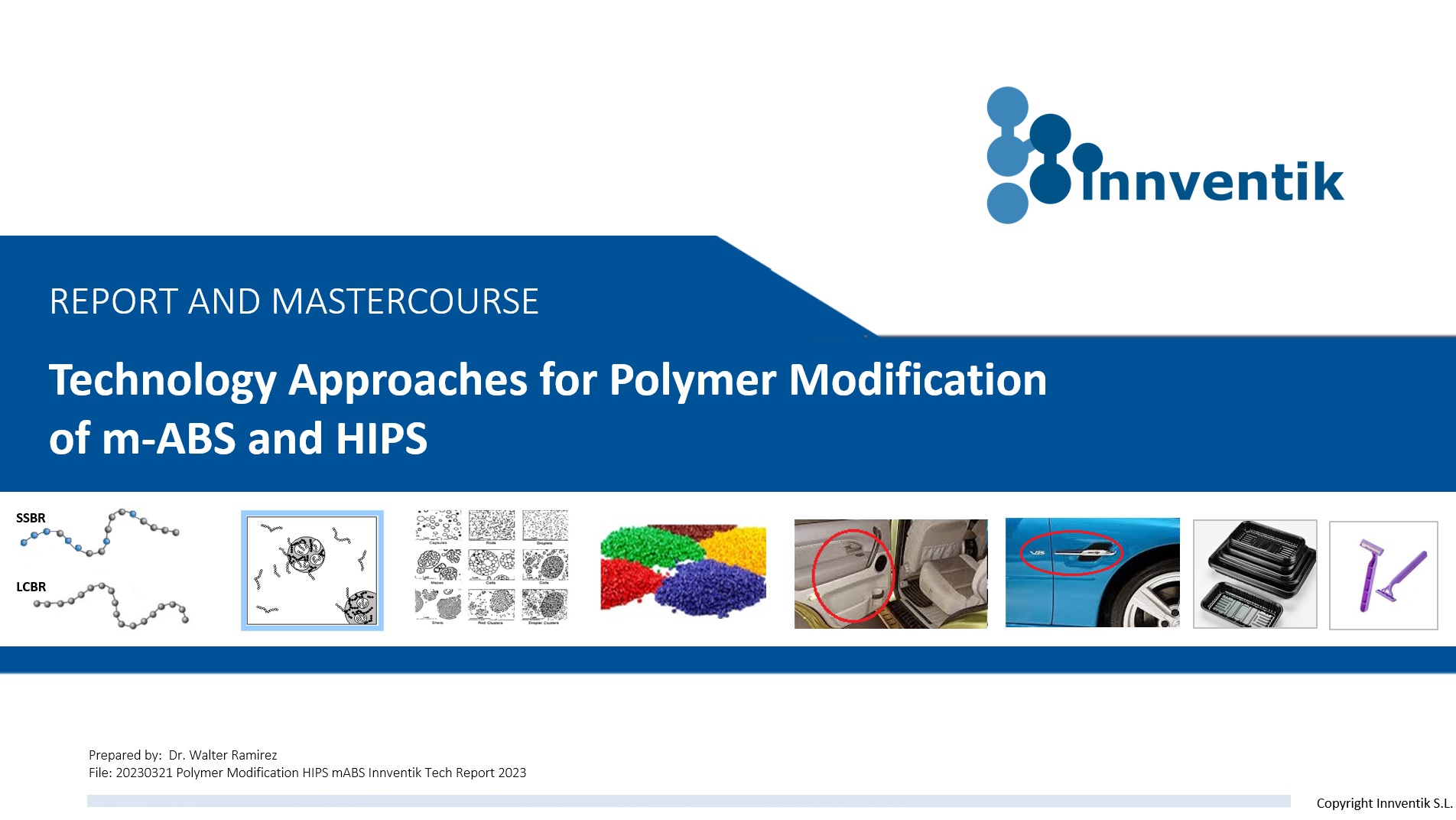
Technology Approaches for Polymer Modification of m-ABS and HIPS
- Home Articles & Publications
- Technology Approaches for Polymer Modification of m-ABS and HIPS
Technology Approaches for Polymer Modification of m-ABS and HIPS

Madrid, March 2023. Innventik has announced the release of its “Technology Approaches for Polymer Modification of m-ABS and HIPS Report 2023“. The report addresses the synthesis-structure-property-performance relations for the synthesis of in-situ polymerization of continuous mass Acrylonitrile-Butadiene-Styrene polymers (ABS) and High Impact Polystyrene (HIPS). The report includes the fundamentals for the synthesis and structure of Low Cis Polybutadiene Rubber (LCBR) and Solution Styrene Butadiene Rubber (SSBR) used for Rubber Toughening and addresses mechanical blending approaches and key information from market applications, users. and innovation trends. Innventik is a Consulting and Engineering company that has a team of experts that provides services to companies around the world with process improvements, engineering (FEL2, FEL3), Technology-Market Intelligence in Rubber, Elastomers, and Polymer Modification (ABS, HIPS).
The contents of the Technology Report are:
- MODULE 1: DESIGN PARAMETERS
- MODULE 2: RUBBER SELECTION CRITERIA
- MODULE 3: ROLE OF RUBBER TYPE AND PERFORMANCE
- MODULE 4: m-ABS AND HIPS PROCESSES AND PROPERTIES
- MODULE 5: INNOVATION TRENDS & PATENT ANALYSIS
- MODULE 6: IN-SITU POLYMERIZATION KINETICS
- MODULE 7: ANIONIC POLYMERIZATION DESIGN OF LCBR & SSBR
- MODULE 8: ALKYL-LITHIUM INITIATORS
- MODULE 9: MOLECULAR WEIGHT & DISTRIBUTION
- MODULE 10: MICROSTRUCTURE OF POLYDIENES
- MODULE 11: RUBBER TOUGHENING WITH BLENDS
- MODULE 12: MECHANICAL BLENDING APPROACHES
- MODULE 13: KEY INFORMATION FROM MARKET, CUSTOMERS, USERS
- MODULE 14: ABS AND HIPS MARKET INSIGHTS
FREE ACCESS TO INNVENTIK EXPERTS.
All report purchases include free access for up to 30 min. phone time with the expert, who will help you link key findings in the report to the technical, market, or application issues you are addressing. Also available as Mastercourse (online or in-house training format).
ORDERING INFORMATION
□ Electronic (unlimited users): 4995€
- An electronic pdf version of a fully illustrated report, +380 pages, PDF format, will be delivered after payment.
- An Excel database with active links to access individual patents is included in the package.
To request more information or a copy of this report, training, consulting, or engineering.
Email: walter@innventik.com
Phone: +34 628859711 (Europe CST)
DETAILED CONTENTS
MODULE 1: DESIGN PARAMETERS IN THE SYNTHESIS OF m-ABS & HIPS
• Types of Processes to obtain m-ABS and HIPS
• Rubber Toughened Plastics Morphology
• Mechanism of particle Formation and Morphology
• Effect of Graft or Block Copolymer on Morphology
• Impact-Gloss balance with Rubber Particle Size
• Materials Science Concepts of Rubber Toughened Polymers
• Role of Rubber Type and Characteristics
• Key points
MODULE 2: RUBBER SELECTION CRITERIA FOR m-ABS AND HIPS
• Rubber Selection Parameters
• Role of Rubber Type and Characteristics
• Typical Rubber Specification for HIPS
• Solution Viscosity Relevance
• Screening rubbers for colors
• Plant Trials
MODULE 3: ROLE OF RUBBER TYPE AND PERFORMANCE
• Review of Plastics Testing
• Review of Polymerization Process
• Polymer Structure
• Key Control Properties
• Factors that control Properties and challenges
MODULE 4: m-ABS AND HIPS PROCESSES AND PROPERTIES
• Main processes
• Comparison of technologies
• Major processing methods
MODULE 5: m-ABS AND HIPS INNOVATION TRENDS AND PATENT ANALYSIS
• Technology Strategies of major players
• Key parameters to control performance
• Novel processes (HIPS, TIPS, CRP)
• Recent advances in Polymer Modification
• Patent analysis, key technologies and trends
MODULE 6: IN-SITU POLYMERIZATION KINETICS
• Polymerization of Styrene in Rubber
• Kinetics and initiators (diradical initiation)
MODULE 7: ANIONIC POLYMERIZATION DESIGN OF LCBR AND SSBR
• Basic concepts in anionic polymerization
• Types of solvents
• Controlling Molecular weight and distribution
• Block Copolymers
• Radial Polymers
• Functionalization
MODULE 8: STRUCTURE OF ALKYL-LITHIUM INITIATORS
• Structure of alkyl-lithium initiators
• Initiation and propagation
MODULE 9: MOLECULAR WEIGHT AND DISTRIBUTION
• Methods
• Styrene-Butadiene Copolymers analysis
MODULE 10: MICROSTRUCTURE OF POLYDIENES
• Microstructure and characterization
• Addition of Lewis Basis
• Polar Modifiers
• Coupling Agents
• Poisons
• Copolymerization control
MODULE 11: RUBBER TOUGHENED m-ABS & HIPS WITH RUBBER BLENDS
• BR and SSBR Blends cases
• Key points
MODULE 12: MECHANICAL BLENDING APPROACHES FOR ABS & HIPS
• Rheology of miscible blends
• Comparative Morphologies
• Results of mechanical blending (blend and graft types)
• Properties of the matrix
MODULE 13: KEY INFORMATION FROM MARKET, CUSTOMERS, USERS
• Designing new products based on unmet needs
• Differentiation ideas
MODULE 14: ABS AND HIPS MARKET INSIGHTS
• General market overview of ABS
• General market overview of Polystyrene

